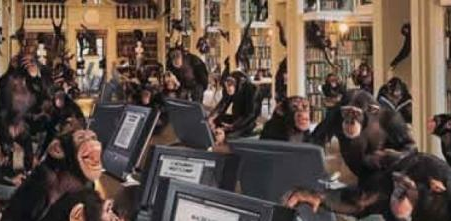
One of the most widespread arguments justifying that financial markets can be considered random is the monkey example: if we assume there are an infinite number of monkeys, each one in front of a typewriter pressing keys at random for an infinite amount of time, surely it can be statistically affirmed that one of them will sooner or later type The Divine Comedy word-for-word. Switching back to S&P500, its history can be reproduced exactly by using one of the infinite random historical series generated by a Montecarlo engine and conducting an extraction of random returns.
I’ll add that just because a monkey can perfectly replicate The Divine Comedy, doesn’t make The Divine Comedy an aggregate of random letters that created a masterpiece, it is the fruit of extraordinary genius and intellect. The trends of the S&P500 are equally unrepeatable and generated by a sequence of events that have determined its results day after day.
Try to convince me that on September 11th, 2001 the market lost 7% due to coincidence.
Why am I emphasizing this point? Because to consider the surely uncertain trends of financial markets as random is an intellectual scam, as Nassim Nicholas Taleb claims in his book The Black Swan (which I agree with 90%, but don’t ask me which 10% I disagree with).
It’s an intellectual scam because it takes the focus away from some very interesting aspects and structural features of the financial markets, especially equity markets.
Those who have worked in the stock market for several years can’t help but notice the existence of trends, more or less solid, that characterize its performance. Trends are easy to explain, they’re due to behavioral finance phenomena rather than price logic. Since estimating the correct price of a stock is quite difficult and there are many models to do it (and none are perfect), their price over time will fluctuate around an average price based on other factors, which are mainly due to emotionality, to the expectations and perceptions of people, rather than the rationality of estimation modes. This becomes even more evident and striking if we look at the performance of the indices, an encompassment of the expectations of economic growth mixed with fear and greed, typical of the average investor.
Thus, irrational fears or speculative bubbles are created, which lead to considerable distortions of reality and of the real price of one or more companies (they can be exceptional opportunities for those who know how to read them).
The past 14 years have brought about some striking trends: from March 2000 to March 2003 there was a frightening downward trend that shook the financial markets, from March 2003 to March 2007 there was an equally powerful upward trend that brought the indices close to new highs, March 2007 to March 2009, a new, very heavy bearish trend, and from March 2009 to March 2014, another exceptional trend.
Some of you might think that once again we’re headed towards a bearish trend, it’s possible, though no one can know in advance. There are good techniques to estimate the existence of trends and ride them out with the goal of benefiting from them, especially in terms of minor losses.
